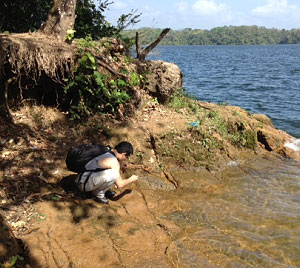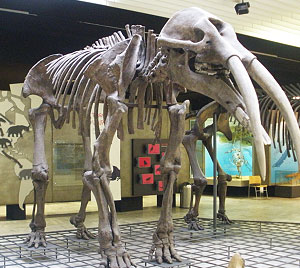By Bruce MacFadden | PCP PIRE Principal Investigator

In January 2014, Doug Jones, Aldo Rincon and I went to Panama in search of ancient gomphotheres, a primitive group of elephant-like proboscideans from the Old World that migrated across an ancient land bridge to North America about 15 million years ago. The reasons for suspecting the presence of gomphotheres in Panama is yet another example of serendipity in science.
In July 2013 I gave a talk about PCP PIRE to the Panama Canal Society in Orlando, Florida. After my talk, John Turner—who grew up in the Canal Zone—brought to my attention a tooth of a primitive elephant-like mammal that he had collected in 1959 while he was at the Madden Boy Scout Camp. After Gary Morgan, a colleague from the New Mexico Museum of Natural History, and I had the chance to examine the fossil, we realized that it was something very exciting. It likely represents Gomphotherium, an extinct genus that was widespread during the Miocene.

With this exciting discovery, one of our goals for our recent January field trip was to re-locate the fossil horizon on the lake shore where John Turner collected his fossil in 1959. In addition to John Turner’s recollections from a half century ago, we turned to published reports and geological maps of the region to narrow the focus of our field reconnaissance. We are pleased to report that we were successful and located the fossiliferous layer from the general area where the tooth was found. We plan to return to this area when the lake levels are lower, hoping that more fossiliferous Miocene sediments will be exposed.
Although extinct mastodonts (Cuvieronius) have been found in Pleistocene sediments around the Pearl Islands and on the Azuero peninsula, no earlier, more primitive forms such as Gomphotherium were previously known from Panama. The presence of Gomphotherium, and the potential for additional finds with further searching in the field, will likely turn up more evidence of extinct land-dwelling species from a time during the middle Miocene not yet reported from Panama. These discoveries will also document southward dispersal of immigrant taxa from the Old World and higher latitude North America during the Miocene. (Coming in the next issue—a profile of John Turner)

By Bruce MacFadden | PCP PIRE Principal Investigator
En enero del 2014, Doug Jones, Aldo Rincón y yo fuimos a Panamá en busca de gonfoterios antiguos, un grupo primitivo de proboscideanos tipo elefante del Viejo Mundo que migraron a través de un antiguo puente de tierra a América del Norte hace unos 15 millones de años. Las razones para sospechar la presencia de gonfoterios en Panamá es un ejemplo más de la serendipia en la ciencia.
En julio de 2013 di una charla sobre PCP PIRE a la Sociedad del Canal de Panamá, en Orlando, Florida. Después de mi charla, John Turner-que creció en la Zona del Canal me mostró un diente de un mamífero parecido al elefante primitivo que había recogido en 1959 mientras se encontraba en el Madden Boy Scout Camp. Después de Gary Morgan, un colega del Museo de Nuevo México de Historia Natural, y yo tuvimos la oportunidad de examinar el fósil, nos dimos cuenta de que era algo muy emocionante. Probablemente representa Gomphotherium, un género extinto que fue generalizada durante el Mioceno.

Con este descubrimiento emocionante, una de nuestras metas para nuestro reciente viaje de campo de enero fue volver a ubicar el horizonte del fósil en la orilla del lago, donde John Turner recogió su fósil en 1959. Además de los recuerdos de John Turner desde hace medio siglo, recurrimos a los informes publicados y mapas geológicos de la región para reducir el foco de nuestro reconocimiento de campo. Nos complace informar que hemos tenido éxito y ubicamos la capa fosilífera de la zona general donde se encontró el diente. Tenemos la intención de volver a esta zona, cuando los niveles de los lagos son más bajos, con la esperanza de que los sedimentos fosilíferas del Mioceno serán más expuestos.
Aunque mastodontes extintos (Cuvieronius) se han encontrado en los sedimentos del Pleistoceno alrededor de las Islas de las Perlas, y en la península de Azuero, no antes, las formas más primitivas como Gomphotherium han sido previamente encontrados en Panamá. La presencia de Gomphotherium, y el potencial para descubrimientos adicionales con más de búsqueda en el campo, probablemente proveerá más pruebas de las especies terrestres extintas que habitan durante el Mioceno medio que no han sido reportadas en Panamá. Estos descubrimientos también documentarán la dispersión hacia el sur de los taxones inmigrantes del Viejo Mundo y una mayor latitud de América del Norte durante el Mioceno. (En la próxima edición-un perfil de John Turner)